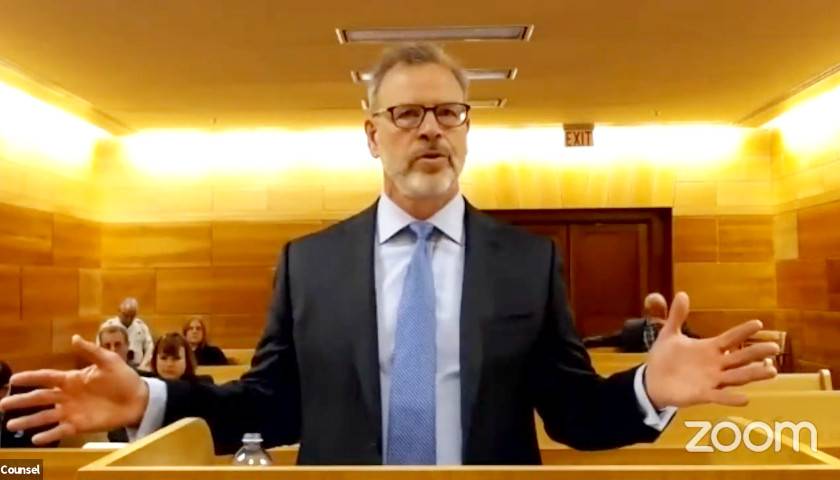A panel of three Arizona Court of Appeals judges heard oral arguments on Thursday in Kari Lake’s Rule 60(b) appeal of her election lawsuit. Lake’s attorney, Kurt Olsen, alleged that Maricopa County Co-Elections Director Scott Jarrett told numerous lies.
Lake’s team filed the Rule 60(b) motion requesting a second trial based on newly found evidence, but the trial court judge, Maricopa County Superior Court Judge Peter Thompson, greatly limited the scope of her second trial and then ruled against her.
Olsen said during oral argument that the Rule 60(b) motion addressed three new types of evidence that emerged after the original trial. He said the Rule 60(b) motion addressed three new types of evidence that emerged after the original trial. He said first, they discovered that Maricopa County did not comply with the mandatory Logic & Accuracy tests on the voting machine tabulators.
Second, they discovered that the county “conducted unannounced testing on the tabulators using the vote centers prior to Election Day.” He noted that out of the 466 tabulators used on Election Day, 260 rejected ballots and were “not corrected.” The new evidence showed that the county failed to complete the testing on the tabulators used on Election Day and instead only tested five backup tabulators that were not used.
Third, Olsen said it was revealed after the trial that Jarrett “repeatedly gave false and misleading testimony on these issues regarding the tabulators that serve to either cover up or to mislead the court as to what happened.”
He said the new evidence showed that the SLOG files, which are worksharing log files, from the election showed that the tabulators rejected over 7,000 ballots every 30 minutes all day from 6:30 a.m. until 8 p.m., and 71 percent of the vote centers experienced rejections higher than 20 percent. He noted that the U.S. Election Assistance Commission only permits a maximum rejection rate of 0.2 percent or about 1 out of every 500 ballots.
At that point, Judge Peter Eckerstrom, who was one of Democratic Governor Janet Napolitano’s first appointments to the bench, interrupted Olsen and said, “And counsel, I’m sure you’re aware we’re not actually a fact-finding court, we’re where the court decides questions of law primarily in the context of facts.”
Olsen responded and said he was bringing up new evidence discovered after the initial trial, which is appropriate in a Rule 60(b) appeal, but he moved on to discuss how he said he believed Thompson erred.
Olsen said Thompson made three errors. First, Thompson said fraud was required to be shown, but for a 60(b) appeal, only “simple negligence” is required, Olsen said.
Other judges who ruled on the 2020 election lawsuits have held that fraud is not the standard.
In RNC v. Weipert, District Court Judge Ian K. Thornhill found that the mere possibility of fraud was enough to grant an injunction stopping an illegal action by an election official.
Similarly, in RNC v. Gill, Thornhill said, “What the Defendants want the Plaintiffs to be required to do is to prove that fraud has already occurred before they can establish their injury,” he said. “From a practical perspective, once fraud has occurred it will already likely be too late.”
Second, Olsen said that Thompson ruled that the defendants’ expert undermined their cybersecurity expert Clay Parikh’s testimony, but Olsen noted that their expert didn’t examine the tabulator logs, which were only finally obtained after the trial.
Judge Sean Brearcliffe told Olsen that Thompson was entitled to weigh the testimony of one expert against another. Olsen responded by pointing out that Thompson “disregarded the evidence.”
Brearcliffe then asked, “How do we know he disregarded the evidence?”
Olsen said, “He looked at it through the lens of proving fraud.”
Olsen criticized Jarrett for characterizing the ballot tabulator problems on Election Day as a “simple hiccup.” Instead, Olsen said the “disruptions were massive.”
Olsen emphasized that the Logic & Accuracy statute is a “non-technical statute,” which courts have ruled “cannot be ignored.” He said three times as many Republicans showed up to vote on Election Day, and the vote centers that were the most affected by the ballot tabulation problem had the most Republican check-ins. He said that at least 6,700 votes were “apparently not counted.”
Brearcliffe challenged him that 6,700 wasn’t enough to change the election results in Lake’s race, and Olsen responded and pointed out it was “at least” 6,700 votes. The standard for overturning elections in Arizona case law is not whether it would have changed the outcome of the election but merely whether it would have cast doubt on the results. The pivotal case in this area is Reyes v. Cuming.
Olsen accused Jarrett of providing false testimony by stating that Lake’s team never requested the tabulator logs. He said her attorneys, Tim LaSota and Jennifer Wright, requested them, and their request was shown to Thompson.
Next, Olsen said Jarrett claimed that only 1,300 ballots were subject to duplication due to the tabulator problems, but that wasn’t true since the tabulator logs showed there were at least 8,000.
Olsen laid out the statutory requirements for the Logic & Accuracy testing. There must be advance notice provided 48 hours before the testing. It cannot be done “more than 30 days in advance of the election.” It is required to be open to the public to observe.
Olsen cited the Arizona Supreme Court case Moreno v. Jones, which held that new evidence that came out after an initial trial — in that case, a declaration of a woman who had personally signed a petition — was not barred from consideration by the court as too late.
Maricopa County Deputy County Attorney Tom Liddy provided the defendants’ oral argument. He said, “Not one ballot was rejected. Not a single ballot was rejected.”
However, he did not discuss the numerous voters who could not vote because they could not wait in the long lines, so they left. He also did not address the voters who looked up the status of their ballot on the county’s website later, and it revealed that no vote had been submitted from them.
“What about the argument that because of the printer problems and the delays caused by those at the individual vote centers that discourage a sufficient number of voters from voting, that the whole result is uncertain?” Liddy asked. “Hogwash. absolute hogwash.”
He admitted there were problems with some of the ballot-on-demand printers in some vote centers. He said all the ballots eventually were counted at the central counting center, emphasizing that “only 17,000” had to be sent to the central counting center since the tabulators kept rejecting them.
He said the new evidence of the failed Logic & Accuracy testing came out too late for the court to address it. He said Lake changed her argument; first, she argued that someone had hacked into the machines, and then she is now trying to claim there were problems with the tabulators. He called it a “Rule 60(b) sleight of hand,” bringing a “brand-new election contest 151 days after the deadline for an election contest.”
Liddy said he disagreed with Thompson that Rule 60(b) applies to election contests but did not intend to address it. He said the legislature created rules for election challenges that make “things move quickly.”
Olsen had reserved a few minutes for a rebuttal and responded to Liddy. He pointed out that Liddy avoided answering whether all tabulators were tested in advance, noting that statutorily compliant Logic & Accuracy testing “would have prevented this whole debacle.”
He said the new evidence revealing that the software was reengineered was discovered late due to the county delaying its response in providing requested records.
“That’s an additional violation,” he declared. “The fact that Jarrett would make a false statement saying they never requested the tabulator log files before Oct. 14 … [is] a deliberate, deliberate falsehood.”
He added, “We don’t know all ballots were tabulated since Logic & Accuracy testing wasn’t conducted on all the tabulators.”
Eckerstrom interrupted Olsen, repeating his objection at the beginning of Olsen’s talk. “We’re a court of law, right, and we don’t look at facts in the first instance, in the thrust of what you’ve been arguing in your summation is about facts and fact finding.”
Olsen went over how he thought Thompson erred again. He said the standard under Rule 60(b) is showing negligence, not fraud, as Thompson held. He refuted Liddy’s claim that the Rule 60(b) motion was merely an amendment, saying the 60(b) appeal is based on the “chaos of the tabulator rejections … all of the new evidence went to the tabulators.”
Until 2020, elections were overturned for reasons such as discovering four voters were ineligible, hundreds of mail-in ballots discovered in a mailbox, and a poll worker informing voters that one of the candidates was deceased. In another case, a judge ordered a new election over one “irregularity.” In another, a judge ordered a new election where it was found that at least two candidates helped bring people to the town’s early voting location who were ineligible to vote.
Olsen is undergoing disciplinary proceedings by the State Bar of Arizona for his work in election cases. The panel said they would issue a ruling soon.
– – –
Rachel Alexander is a reporter at The Arizona Sun Times and The Star News Network. Follow Rachel on Twitter / X. Email tips to [email protected].





